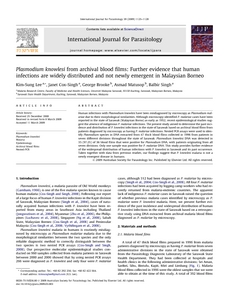Lee, KS; Cox-Singh, J; Brooke, G; Matusop, A; Singh, B
(2009)
Plasmodium knowlesi from archival blood films: Further evidence that human infections are widely distributed and not newly emergent in Malaysian Borneo.
INTERNATIONAL JOURNAL FOR PARASITOLOGY, 39 (10).
1125 - 1128.
ISSN 0020-7519
https://doi.org/10.1016/j.ijpara.2009.03.003
SGUL Authors: Cox-Singh, Janet
![[img]](https://openaccess.sgul.ac.uk/1047/1.hassmallThumbnailVersion/1-s2.0-S0020751909001611-main.pdf)  Preview |
|
["document_typename_application/pdf; charset=binary" not defined]
Published Version
Download (212kB)
| Preview
|
Abstract
Human infections with Plasmodium knowlesi have been misdiagnosed by microscopy as Plasmodium malariae due to their morphological similarities. Although microscopy-identified P. malariae cases have been reported in the state of Sarawak (Malaysian Borno) as early as 1952, recent epidemiological studies suggest the absence of indigenous P. malariae infections. The present study aimed to determine the past incidence and distribution of P. knowlesi infections in the state of Sarawak based on archival blood films from patients diagnosed by microscopy as having P. malariae infections. Nested PCR assays were used to identify Plasmodium species in DNA extracted from 47 thick blood films collected in 1996 from patients in seven different divisions throughout the state of Sarawak. Plasmodium knowlesi DNA was detected in 35 (97.2%) of 36 blood films that were positive for Plasmodium DNA, with patients originating from all seven divisions. Only one sample was positive for P. malariae DNA. This study provides further evidence of the widespread distribution of human infections with P. knowlesi in Sarawak and its past occurrence. Taken together with data from previous studies, our findings suggest that P. knowlesi malaria is not a newly emergent disease in humans.
| Item Type: |
Article
|
| Additional Information: |
Copright: 2009 Australian Society for Parasitology Inc. Published by Elsevier Ltd. Under a Creative Commons license CC BY 3.0 |
| Keywords: |
Animals, Borneo, DNA, Protozoan, Diagnosis, Differential, Female, Humans, Incidence, Malaria, Male, Plasmodium knowlesi, Plasmodium malariae, Polymerase Chain Reaction, Retrospective Studies, Science & Technology, Life Sciences & Biomedicine, Parasitology, Plasmodium knowlesi, Malaria, Epidemiology, Archival blood films, Nested-PCR, POLYMERASE CHAIN-REACTION, ANOPHELES-LEUCOSPHYRUS, MALARIA PARASITES, STAINED THICK, DNA, AMPLIFICATION, TRANSMISSION, SMEARS, SENSITIVITY |
| Journal or Publication Title: |
INTERNATIONAL JOURNAL FOR PARASITOLOGY |
| ISSN: |
0020-7519 |
| Related URLs: |
|
| Dates: |
| Date | Event |
|---|
| 1 August 2009 | Published |
|
| Web of Science ID: |
WOS:000268339400010 |
 |
Download EPMC Full text (HTML)
|
| URI: |
https://openaccess.sgul.ac.uk/id/eprint/1047 |
| Publisher's version: |
https://doi.org/10.1016/j.ijpara.2009.03.003 |
Statistics
Item downloaded times since 19 Sep 2014.
Actions (login required)
 |
Edit Item |


